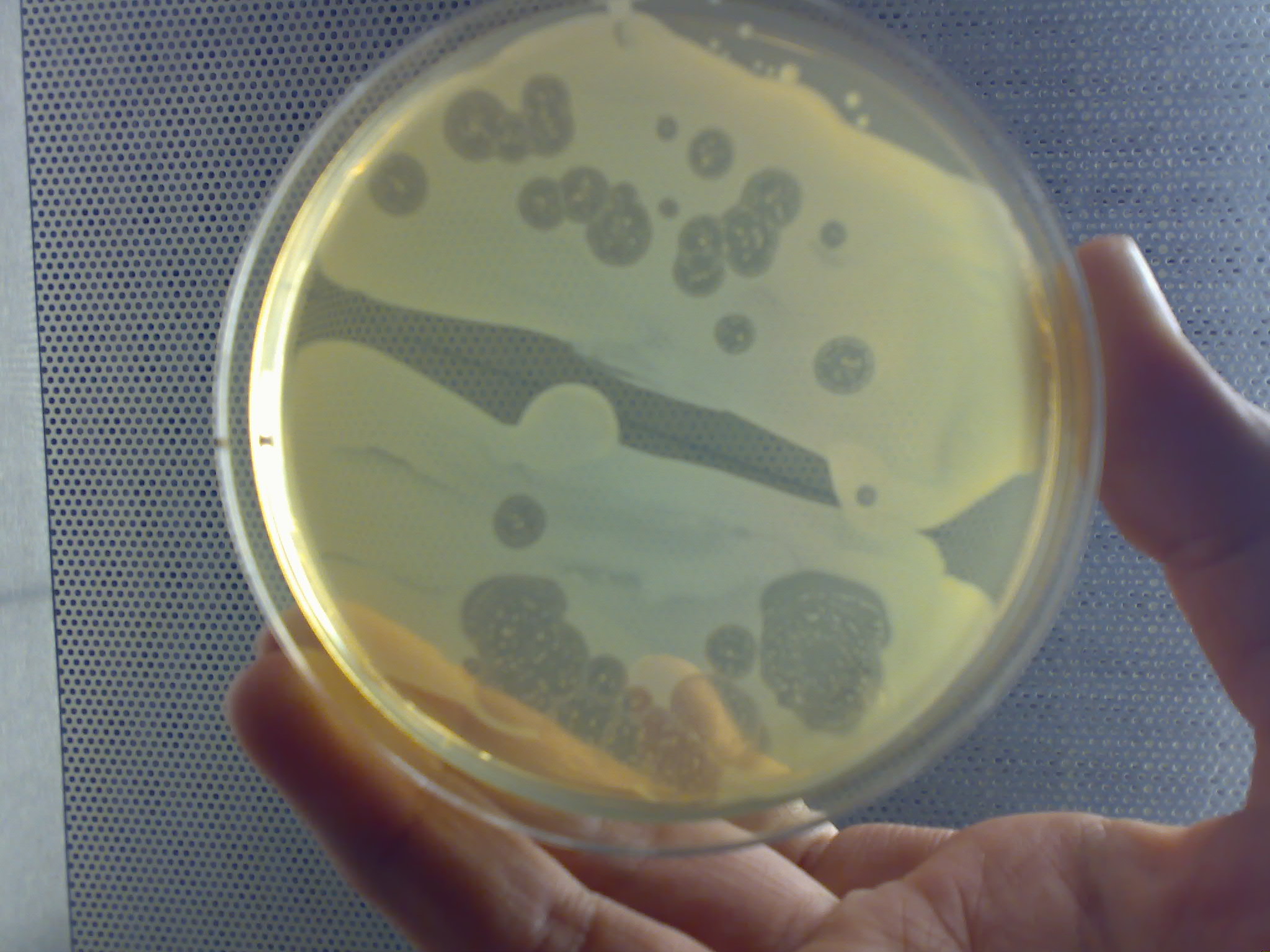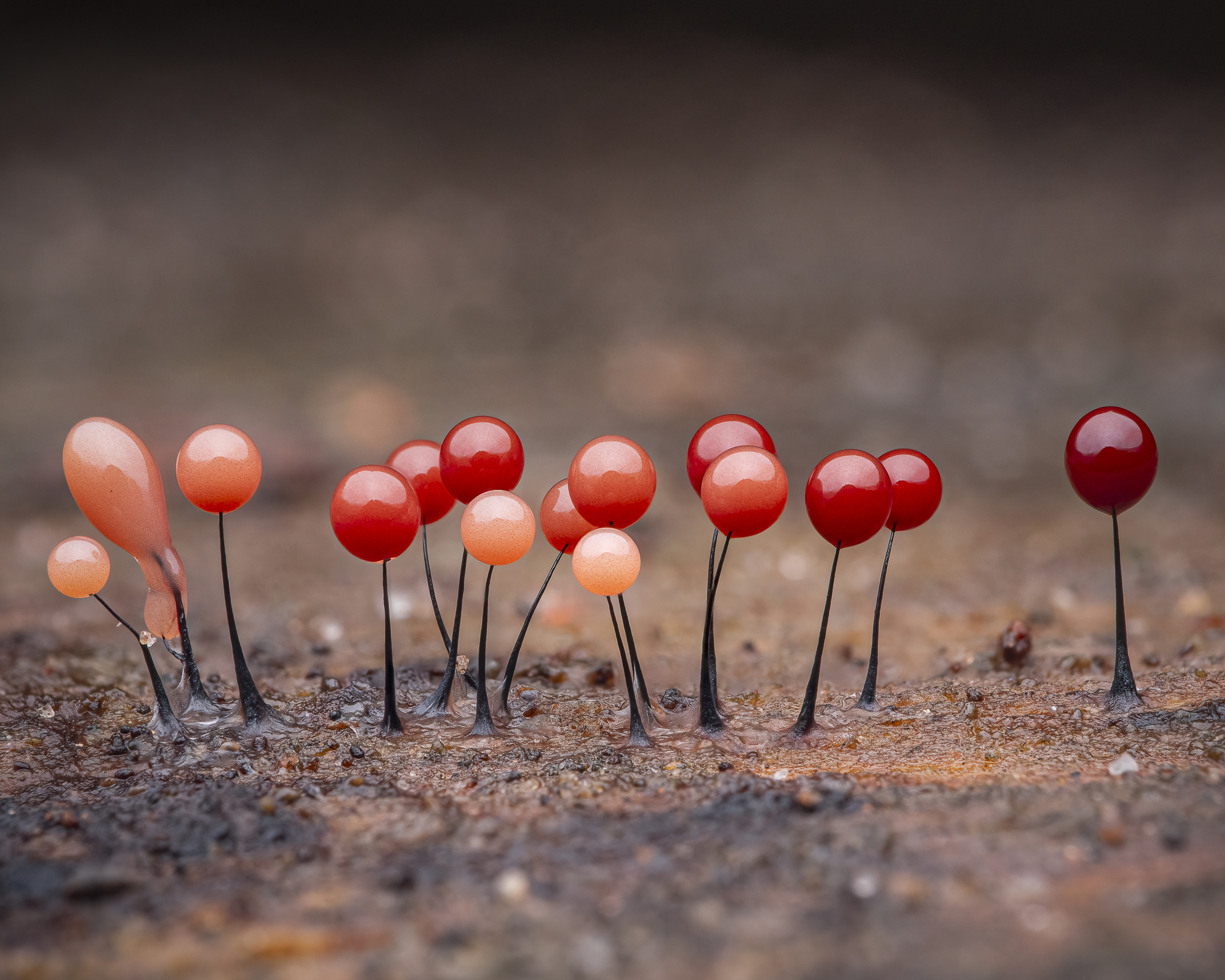|
Dictyosteliid
The dictyostelids (Dictyostelia/Dictyostelea, ICZN, Dictyosteliomycetes, ICBN) or cellular slime molds are a group of slime molds or social amoebae. Multicellular behavior When food (normally bacteria) is readily available dictyostelids behave as individual amoebae, which feed and divide normally. However, when the food supply is exhausted, they aggregate to form a multicellular assembly, called a pseudoplasmodium, grex, or slug (not to be confused with the gastropod mollusc called a slug). The grex has a definite anterior and posterior, responds to light and temperature gradients, and has the ability to migrate. Under the correct circumstances the grex matures forming a sorocarp (fruiting body) with a stalk supporting one or more sori (balls of spores). These spores are inactive cells protected by resistant cell walls, and become new amoebae once food is available. In ''Acytostelium'', the sorocarp is supported by a stalk composed of cellulose, but in other dictyostelids ... [...More Info...] [...Related Items...] OR: [Wikipedia] [Google] [Baidu] |
Slime Mold
Slime mold or slime mould is an informal name given to a polyphyletic assemblage of unrelated eukaryotic organisms in the Stramenopiles, Rhizaria, Discoba, Amoebozoa and Holomycota clades. Most are near-microscopic; those in the Myxogastria form larger plasmodial slime molds visible to the naked eye. The slime mold life cycle includes a free-living single-celled stage and the formation of spores. Spores are often produced in macroscopic multicellular or multinucleate fruiting bodies that may be formed through aggregation or fusion; aggregation is driven by chemical signals called acrasins. Slime molds contribute to the decomposition of dead vegetation; some are parasitic. Most slime molds are terrestrial and free-living, typically in damp shady habitats such as in or on the surface of rotting wood. Some myxogastrians and protostelians are aquatic or semi-aquatic. The phytomyxea are parasitic, living inside their plant hosts. Geographically, slime molds are cosmopo ... [...More Info...] [...Related Items...] OR: [Wikipedia] [Google] [Baidu] |
Grex (biology)
A grex (also called a pseudoplasmodium, or slug) starts as a crowd of single-celled amoebae of the groups Acrasiomycota or Dictyosteliida; ''grex'' is the Latin word for ''flock''. The cells flock together, forming a mass that behaves as an organised, slug-like unit. Before they get stimulated to crowd together to form a grex, the amoebae simply wander as independent cells grazing on bacteria and other suitable food items. They continue in that way of life as long as conditions are favourable. When the amoebae are stressed, typically by a shortage of food, they form a grex. According to species and circumstances, details of the shape of the grex and how it may form will vary but typically the stressed amoebae first produce pheromone A pheromone () is a secreted or excreted chemical factor that triggers a social response in members of the same species. Pheromones are chemicals capable of acting like hormones outside the body of the secreting individual, to affect the behav ... [...More Info...] [...Related Items...] OR: [Wikipedia] [Google] [Baidu] |
Dictyostelium Discoideum
''Dictyostelium discoideum'' is a species of soil-dwelling Amoeboid, amoeba belonging to the phylum Amoebozoa, infraphylum Mycetozoa. Commonly referred to as slime mold, ''D. discoideum'' is a eukaryote that transitions from a collection of unicellular amoebae into a multicellular slug and then into a fruiting body within its lifetime. Its unique asexual Biological life cycle, life cycle consists of four stages: vegetative, aggregation, migration, and culmination. The life cycle of ''D. discoideum'' is relatively short, which allows for timely viewing of all stages. The cells involved in the life cycle undergo movement, chemical signaling, and development, which are applicable to human cancer research. The simplicity of its life cycle makes ''D. discoideum'' a valuable model organism to study genetic, cellular, and biochemical processes in other organisms. Natural habitat and diet In the wild, ''D. discoideum'' can be found in soil and moist leaf litter. Its primary diet consists ... [...More Info...] [...Related Items...] OR: [Wikipedia] [Google] [Baidu] |
Sorocarp
A sorocarp (from the Greek word ''soros'' "a heap" + ''karpos'' "fruit") is the fruiting body characteristic of certain cellular slime moulds (e.g., Dictyosteliida). Each sorocarp consists of both a sorophore (stalk) and a sorus.Lawrence, E. 2005. Henderson's Dictionary of Biology, 13th Ed. Prentice Hall, London Sorocarps release spore In biology, a spore is a unit of sexual reproduction, sexual (in fungi) or asexual reproduction that may be adapted for biological dispersal, dispersal and for survival, often for extended periods of time, in unfavourable conditions. Spores fo ...s. References Mycetozoa {{microbiology-stub ... [...More Info...] [...Related Items...] OR: [Wikipedia] [Google] [Baidu] |
Amoeba
An amoeba (; less commonly spelled ameba or amœba; : amoebas (less commonly, amebas) or amoebae (amebae) ), often called an amoeboid, is a type of Cell (biology), cell or unicellular organism with the ability to alter its shape, primarily by extending and retracting pseudopodia, pseudopods. Amoebae do not form a single Taxonomy (biology), taxonomic group; instead, they are found in every major Lineage (evolution), lineage of eukaryote, eukaryotic organisms. Amoeboid cells occur not only among the protozoa, but also in fungi, algae, and animals. Microbiologists often use the terms "amoeboid" and "amoeba" interchangeably for any organism that exhibits amoeboid movement. In older classification systems, most amoebae were placed in the Class (biology), class or subphylum Sarcodina, a grouping of Unicellular organism, single-celled organisms that possess pseudopods or move by protoplasmic flow. However, molecular phylogenetic studies have shown that Sarcodina is not a monophyletic ... [...More Info...] [...Related Items...] OR: [Wikipedia] [Google] [Baidu] |
Dictyostelium
''Dictyostelium'' is a genus of single- and multi-celled eukaryotic, phagotrophic bacterivores. Though they are Protista and in no way fungal, they traditionally are known as "slime molds". They are present in most terrestrial ecosystems as a normal and often abundant component of the soil microflora, and play an important role in the maintenance of balanced bacterial populations in soils. The genus ''Dictyostelium'' is in the order Dictyosteliida, the so-called cellular slime molds or social amoebae. In turn the order is in the infraphylum Mycetozoa. Members of the order are of great theoretical interest in biology because they have aspects of both unicellularity and multicellularity. The individual cells in their independent phase are common on organic detritus or in damp soils and caves. In this phase they are amoebae. Typically, the amoebal cells grow separately and wander independently, feeding mainly on bacteria. However, they interact to form multi-cellular ... [...More Info...] [...Related Items...] OR: [Wikipedia] [Google] [Baidu] |
Dicty Life Cycle H01
''Dictyostelium discoideum'' is a species of soil-dwelling amoeba belonging to the phylum Amoebozoa, infraphylum Mycetozoa. Commonly referred to as slime mold, ''D. discoideum'' is a eukaryote that transitions from a collection of unicellular amoebae into a multicellular slug and then into a fruiting body within its lifetime. Its unique asexual life cycle consists of four stages: vegetative, aggregation, migration, and culmination. The life cycle of ''D. discoideum'' is relatively short, which allows for timely viewing of all stages. The cells involved in the life cycle undergo movement, chemical signaling, and development, which are applicable to human cancer research. The simplicity of its life cycle makes ''D. discoideum'' a valuable model organism to study genetic, cellular, and biochemical processes in other organisms. Natural habitat and diet In the wild, ''D. discoideum'' can be found in soil and moist leaf litter. Its primary diet consists of bacteria, such as ''Escheric ... [...More Info...] [...Related Items...] OR: [Wikipedia] [Google] [Baidu] |
Cellular Differentiation
Cellular differentiation is the process in which a stem cell changes from one type to a differentiated one. Usually, the cell changes to a more specialized type. Differentiation happens multiple times during the development of a multicellular organism as it changes from a simple zygote to a complex system of tissues and cell types. Differentiation continues in adulthood as adult stem cells divide and create fully differentiated daughter cells during tissue repair and during normal cell turnover. Some differentiation occurs in response to antigen exposure. Differentiation dramatically changes a cell's size, shape, membrane potential, metabolic activity, and responsiveness to signals. These changes are largely due to highly controlled modifications in gene expression and are the study of epigenetics. With a few exceptions, cellular differentiation almost never involves a change in the DNA sequence itself. Metabolic composition, however, gets dramatically altered where st ... [...More Info...] [...Related Items...] OR: [Wikipedia] [Google] [Baidu] |
Programmed Cell Death
Programmed cell death (PCD) sometimes referred to as cell, or cellular suicide is the death of a cell (biology), cell as a result of events inside of a cell, such as apoptosis or autophagy. PCD is carried out in a biological process, which usually confers advantage during an organism's biological life cycle, lifecycle. For example, the Limb development, differentiation of fingers and toes in a developing human embryo occurs because cells between the fingers apoptose; the result is that the digits are separate. PCD serves fundamental functions during both plant and animal tissue development. Apoptosis and autophagy are both forms of programmed cell death. Necrosis is the death of a cell caused by external factors such as trauma or infection and occurs in several different forms. Necrosis was long seen as a non-physiological process that occurs as a result of infection or injury, but in the 2000s, a form of programmed necrosis, called necroptosis, was recognized as an alternative f ... [...More Info...] [...Related Items...] OR: [Wikipedia] [Google] [Baidu] |
DictyBase
dictyBase is an online bioinformatics database for the model organism ''Dictyostelium discoideum ''Dictyostelium discoideum'' is a species of soil-dwelling Amoeboid, amoeba belonging to the phylum Amoebozoa, infraphylum Mycetozoa. Commonly referred to as slime mold, ''D. discoideum'' is a eukaryote that transitions from a collection of unic ...''. Tools dictyBase offers many ways of searching and retrieving data from the database: * dictyMart - a tool for retrieving varied information on many genes (or the sequences of those genes). * Genome Browser - browse the genes of ''D. discoideum'' in their genomic context. References External links dictyBase Developmental biology Model organism databases Mycetozoa {{biodatabase-stub ... [...More Info...] [...Related Items...] OR: [Wikipedia] [Google] [Baidu] |




